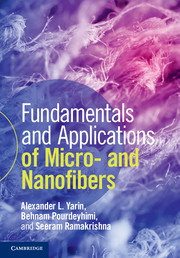Book contents
- Frontmatter
- Contents
- Preface
- 1 Introduction
- 2 Polymer physics and rheology
- 3 General quasi-one-dimensional equations of dynamics of free liquid jets, capillary and bending instability
- 4 Melt- and solution blowing
- 5 Electrospinning of micro- and nanofibers
- 6 Additional methods and materials used to form micro- and nanofibers
- 7 Tensile properties of micro- and nanofibers
- 8 Post-processing
- 9 Applications of micro- and nanofibers
- 10 Military applications of micro- and nanofibers
- 11 Applications of micro- and nanofibers, and micro- and nanoparticles: healthcare, nutrition, drug delivery and personal care
- Subject Index
- References
8 - Post-processing
Published online by Cambridge University Press: 05 June 2014
- Frontmatter
- Contents
- Preface
- 1 Introduction
- 2 Polymer physics and rheology
- 3 General quasi-one-dimensional equations of dynamics of free liquid jets, capillary and bending instability
- 4 Melt- and solution blowing
- 5 Electrospinning of micro- and nanofibers
- 6 Additional methods and materials used to form micro- and nanofibers
- 7 Tensile properties of micro- and nanofibers
- 8 Post-processing
- 9 Applications of micro- and nanofibers
- 10 Military applications of micro- and nanofibers
- 11 Applications of micro- and nanofibers, and micro- and nanoparticles: healthcare, nutrition, drug delivery and personal care
- Subject Index
- References
Summary
This chapter discusses several post-processing approaches applied to as-spun nanofibers to change their structure and/or enhance certain properties. Section 8.1 describes carbonization, sol-gel transformation and calcination, as well as metal-plating, used to make stiff, hollow or thermally and electrically conducting fibers. Sections 8.2 and 8.3 are devoted to cross-linking of solution-blown soy protein/nylon 6 nanofibers. The collected fiber mats can be bonded both chemically (using aldehydes and ionic cross-linkers, as in Section 8.2), and physically (by means of wet and thermal treatment, as in Section 8.3) to increase the tensile strength and therefore widen the range of applications of these green nonwovens. Chemical cross-linkers bond different amino groups, primary amides and sulfhydryl groups in the protein structure, which is beneficial for the enhancement of tensile strength. It is shown that treatment with ionic cross-linkers results in nanofiber mats with a higher Young’s modulus. Covalent bonds formed by aldehyde groups have a smaller effect on the mat strength. As cross-linked nanofibers are exposed to heat, the bonds formed between amino groups in the fibers are broken and they became less aggregated. In addition, in Section 8.3 it is shown that wet conglutination of soy protein/nylon 6 nanofiber mats leads to partial physical cross-linking of nanofibers and, consequently, to an increase in Young’s modulus. An enhancement of the tensile strength of soy protein nanofiber mats, as well as a slight plasticizing effect, can also result from exposure to water.
Information
- Type
- Chapter
- Information
- Fundamentals and Applications of Micro- and Nanofibers , pp. 319 - 336Publisher: Cambridge University PressPrint publication year: 2014
